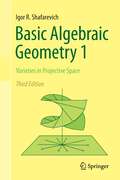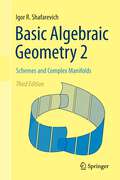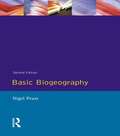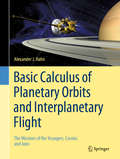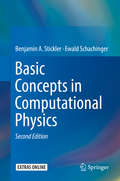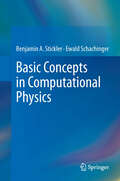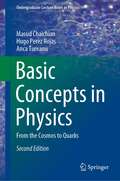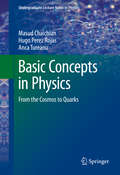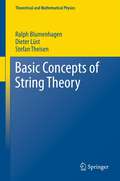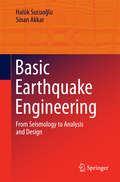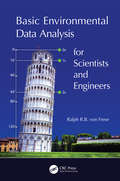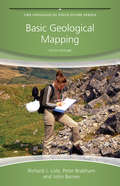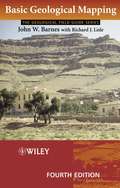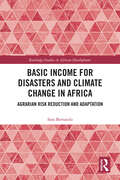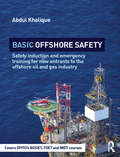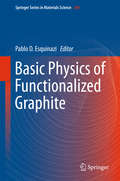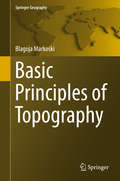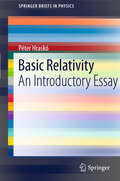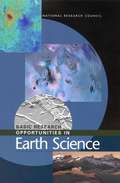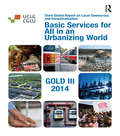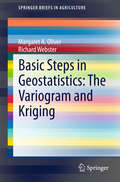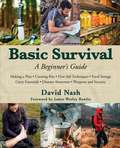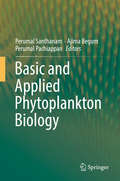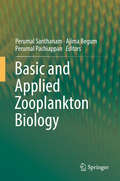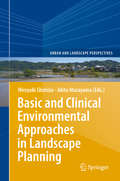- Table View
- List View
Basic Algebraic Geometry 1: Varieties in Projective Space (Springer Study Edition Ser.)
by Miles Reid Igor R. ShafarevichShafarevich's Basic Algebraic Geometry has been a classic and universally used introduction to the subject since its first appearance over 40 years ago. As the translator writes in a prefatory note, ``For all [advanced undergraduate and beginning graduate] students, and for the many specialists in other branches of math who need a liberal education in algebraic geometry, Shafarevich's book is a must.'' The third edition, in addition to some minor corrections, now offers a new treatment of the Riemann--Roch theorem for curves, including a proof from first principles. Shafarevich's book is an attractive and accessible introduction to algebraic geometry, suitable for beginning students and nonspecialists, and the new edition is set to remain a popular introduction to the field.
Basic Algebraic Geometry 2: Schemes and Complex Manifolds
by Miles Reid Igor R. ShafarevichShafarevich's Basic Algebraic Geometry has been a classic and universally used introduction to the subject since its first appearance over 40 years ago. As the translator writes in a prefatory note, ``For all [advanced undergraduate and beginning graduate] students, and for the many specialists in other branches of math who need a liberal education in algebraic geometry, Shafarevich's book is a must.'' The second volume is in two parts: Book II is a gentle cultural introduction to scheme theory, with the first aim of putting abstract algebraic varieties on a firm foundation; a second aim is to introduce Hilbert schemes and moduli spaces, that serve as parameter spaces for other geometric constructions. Book III discusses complex manifolds and their relation with algebraic varieties, Kähler geometry and Hodge theory. The final section raises an important problem in uniformising higher dimensional varieties that has been widely studied as the ``Shafarevich conjecture''. The style of Basic Algebraic Geometry 2 and its minimal prerequisites make it to a large extent independent of Basic Algebraic Geometry 1, and accessible to beginning graduate students in mathematics and in theoretical physics.
Basic Biogeography
by N V PearsFirst published in 1985. This is the is the second edition of a study looking at ecology and biogeography with updated chapters including current research. It starts with the with the study of plants to gain an understanding of the complexities of ecological relationships.
Basic Calculus of Planetary Orbits and Interplanetary Flight: The Missions of the Voyagers, Cassini, and Juno
by Alexander J. HahnIntended for a one- or two-semester course, this text applies basic, one-variable calculus to analyze the motion both of planets in their orbits as well as interplanetary spacecraft in their trajectories. The remarkable spacecraft missions to the inner and outermost reaches of our solar system have been one of the greatest success stories of modern human history. Much of the underlying mathematical story is presented alongside the astonishing images and extensive data that NASA’s Voyager, NEAR-Shoemaker, Cassini, and Juno missions have sent back to us. First and second year college students in mathematics, engineering, or science, and those seeking an enriching independent study, will experience the mathematical language and methods of single variable calculus within their application to relevant conceptual and strategic aspects of the navigation of a spacecraft. The reader is expected to have taken one or two semesters of the basic calculus of derivatives, integrals, and the role that limits play. Additional prerequisites include knowledge of coordinate plane geometry, basic trigonometry, functions and graphs, including trig, inverse, exponential, and log functions. The discussions begin with the rich history of humanity’s efforts to understand the universe from the Greeks, to Newton and the Scientific Revolution, to Hubble and galaxies, to NASA and the space missions. The calculus of polar functions that plays a central mathematical role is presented in a self-contained way in complete detail. Each of the six chapters is followed by an extensive problem set that deals with and also expands on the concerns of the chapter. The instructor has the flexibility to engage them with greater or lesser intensity. “I have been an aerospace engineer for 39 years and honestly, it would be hard for me to overstate how valuable I believe this book will be to numerous scientific and engineering disciplines and in particular to the future of aerospace engineering … This book is perfectly crafted to motivate, educate, and prepare the scientists and engineers who wish to reach for the sky and beyond.” —Dr. Mario Zoccoli, Aerospace Engineer, NASA and Lockheed Martin
Basic Concepts in Computational Physics
by Benjamin A. Stickler Ewald SchachingerThis new edition is a concise introduction to the basic methods of computational physics. Readers will discover the benefits of numerical methods for solving complex mathematical problems and for the direct simulation of physical processes. The book is divided into two main parts: Deterministic methods and stochastic methods in computational physics. Based on concrete problems, the first part discusses numerical differentiation and integration, as well as the treatment of ordinary differential equations. This is extended by a brief introduction to the numerics of partial differential equations. The second part deals with the generation of random numbers, summarizes the basics of stochastics, and subsequently introduces Monte-Carlo (MC) methods. Specific emphasis is on MARKOV chain MC algorithms. The final two chapters discuss data analysis and stochastic optimization. All this is again motivated and augmented by applications from physics. In addition, the book offers a number of appendices to provide the reader with information on topics not discussed in the main text. Numerous problems with worked-out solutions, chapter introductions and summaries, together with a clear and application-oriented style support the reader. Ready to use C++ codes are provided online.
Basic Concepts in Computational Physics
by Ewald Schachinger Benjamin A. SticklerWith the development of ever more powerful computers a new branch of physics and engineering evolved over the last few decades: Computer Simulation or Computational Physics. It serves two main purposes:- Solution of complex mathematical problems such as, differential equations, minimization/optimization, or high-dimensional sums/integrals.- Direct simulation of physical processes, as for instance, molecular dynamics or Monte-Carlo simulation of physical/chemical/technical processes.Consequently, the book is divided into two main parts: Deterministic methods and stochastic methods. Based on concrete problems, the first part discusses numerical differentiation and integration, and the treatment of ordinary differential equations. This is augmented by notes on the numerics of partial differential equations. The second part discusses the generation of random numbers, summarizes the basics of stochastics which is then followed by the introduction of various Monte-Carlo (MC) methods. Specific emphasis is on MARKOV chain MC algorithms. All this is again augmented by numerous applications from physics. The final two chapters on Data Analysis and Stochastic Optimization share the two main topics as a common denominator. The book offers a number of appendices to provide the reader with more detailed information on various topics discussed in the main part. Nevertheless, the reader should be familiar with the most important concepts of statistics and probability theory albeit two appendices have been dedicated to provide a rudimentary discussion.
Basic Concepts in Physics: From the Cosmos to Quarks (Undergraduate Lecture Notes in Physics)
by Masud Chaichian Anca Tureanu Hugo Perez RojasThis book is the second edition of an excellent undergraduate-level overview of classical and modern physics, intended for students of physics and related subjects, and also perfectly suited for the education of physics teachers. The twelve-chapter book begins with Newton’s laws of motion and subsequently covers topics such as thermodynamics and statistical physics, electrodynamics, special and general relativity, quantum mechanics and cosmology , the standard model and quantum chromodynamics. The writing is lucid, and the theoretical discussions are easy to follow for anyone comfortable with standard mathematics.An important addition in this second edition is a set of exercises and problems, distributed throughout the book. Some of the problems aim to complement the text, others to provide readers with additional useful tools for tackling new or more advanced topics. Furthermore, new topics have been added in several chapters; for example, the discovery of extra-solar planets from the wobble of their mother stars, a discussion of the Landauer principle relating information erasure to an increase of entropy, quantum logic, first order quantum corrections to the ideal gas equation of state due to the Fermi-Dirac and Bose-Einstein statistics. Both gravitational lensing and the time-correction in geo-positioning satellites are explained as theoretical applications of special and general relativity. The discovery of gravitational waves, one of the most important achievements of physical sciences, is presented as well. Professional scientists, teachers, and researchers will also want to have this book on their bookshelves, as it provides an excellent refresher on a wide range of topics and serves as an ideal starting point for expanding one’s knowledge of new or unfamiliar fields. Readers of this book will not only learn much about physics, they will also learn to love it.
Basic Concepts in Physics: From the Cosmos to Quarks (Undergraduate Lecture Notes in Physics)
by Masud Chaichian Anca Tureanu Hugo Perez Rojas"Basic Concepts in Physics: From the Cosmos to Quarks" is the outcome of the authors' long and varied teaching experience in different countries and for different audiences, and gives an accessible and eminently readable introduction to all the main ideas of modern physics. The book’s fresh approach, using a novel combination of historical and conceptual viewpoints, makes it ideal complementary reading to more standard textbooks. The first five chapters are devoted to classical physics, from planetary motion to special relativity, always keeping in mind its relevance to questions of contemporary interest. The next six chapters deal mainly with newer developments in physics, from quantum theory and general relativity to grand unified theories, and the book concludes by discussing the role of physics in living systems. A basic grounding in mathematics is required of the reader, but technicalities are avoided as far as possible; thus complex calculations are omitted so long as the essential ideas remain clear. The book is addressed to undergraduate and graduate students in physics and will also be appreciated by many professional physicists. It will likewise be of interest to students, researchers and teachers of other natural sciences, as well as to engineers, high-school teachers and the curious general reader, who will come to understand what physics is about and how it describes the different phenomena of Nature. Not only will readers of this book learn much about physics, they will also learn to love it.
Basic Concepts of String Theory (Theoretical and Mathematical Physics)
by Dieter Lüst Ralph Blumenhagen Stefan TheisenThe purpose of this book is to thoroughly prepare the reader for research in string theory at an intermediate level. As such it is not a compendium of results but intended as textbook in the sense that most of the material is organized in a pedagogical and self-contained fashion. Beyond the basics, a number of more advanced topics are introduced, such as conformal field theory, superstrings and string dualities - the text does not cover applications to black hole physics and cosmology, nor strings theory at finite temperatures. End-of-chapter references have been added to guide the reader wishing to pursue further studies or to start research in well-defined topics covered by this book.
Basic Earthquake Engineering: From Seismology to Analysis and Design
by Sinan Akkar Halûk SucuoğluThis book provides senior undergraduate students, master students and structural engineers who do not have a background in the field with core knowledge of structural earthquake engineering that will be invaluable in their professional lives. The basics of seismotectonics, including the causes, magnitude, and intensity of earthquakes, are first explained. Then the book introduces basic elements of seismic hazard analysis and presents the concept of a seismic hazard map for use in seismic design. Subsequent chapters cover key aspects of the response analysis of simple systems and building structures to earthquake ground motions, design spectrum, the adoption of seismic analysis procedures in seismic design codes, seismic design principles and seismic design of reinforced concrete structures. Helpful worked examples on seismic analysis of linear, nonlinear and base isolated buildings, earthquake-resistant design of frame and frame-shear wall systems are included, most of which can be solved using a hand calculator.
Basic Environmental Data Analysis for Scientists and Engineers
by Ralph R.B. Von FreseClassroom tested and the result of over 30 years of teaching and research, this textbook is an invaluable tool for undergraduate and graduate data analysis courses in environmental sciences and engineering. It is also a useful reference on modern digital data analysis for the extensive and growing community of Earth scientists and engineers. Basic Environmental Data Analysis for Scientists and Engineers introduces practical concepts of modern digital data analysis and graphics, including numerical/graphical calculus, measurement units and dimensional analysis, error propagation and statistics, and least squares data modeling. It emphasizes array-based or matrix inversion and spectral analysis using the fast Fourier transform (FFT) that dominates modern data analysis. Divided into two parts, this comprehensive hands-on textbook is excellent for exploring data analysis principles and practice using MATLAB®, Mathematica, Mathcad, and other modern equation solving software. Part I, for beginning undergraduate students, introduces the basic approaches for quantifying data variations in terms of environmental parameters. These approaches emphasize uses of the data array or matrix, which is the fundamental data and mathematical processing format of modern electronic computing. Part II, for advanced undergraduate and beginning graduate students, extends the inverse problem to least squares solutions involving more than two unknowns. Features: Offers a uniquely practical guide for making students proficient in modern electronic data analysis and graphics Includes topics that are not explained in any existing textbook on environmental data analysis Data analysis topics are very well organized into a two-semester course that meets general education curriculum requirements in science and engineering Facilitates learning by beginning each chapter with an ‘Overview’ section highlighting the topics covered, and ending it with a ‘Key Concepts’ section summarizing the main technical details that the reader should have acquired Indexes many numerical examples for ready access in the classroom or other venues serviced by electronic equation solvers like MATLAB®, Mathematica, Mathcad, etc. Offers supplemental exercises and materials to enhance understanding the principles and practice of modern data analysis
Basic Geological Mapping
by Richard J. Lisle John W. Barnes Peter BrabhamPart of The Geological Field Guide Series, Basic Geological Mapping, 5th Edition is an essential basic guide to field techniques in mapping geology. Now completely revised and updated the book retains the concise clarity which has made it an indispensable instant reference in its previous editions. It provides the reader with all the necessary practical information and techniques that they will need while carrying out work in the field, covering a wide spectrum of different conditions, needs and types of countries. This edition covers new developments in technology including Google Earth and the use of GPS. This is an ideal field guide to geological mapping for 2nd/3rd year undergraduates of Geology, Hydrogeology and Geological Engineering.
Basic Geological Mapping (Geological Field Guide #35)
by Richard J. Lisle John W. BarnesDesigned to be carried in the field, this pocket-sized how-to book is a practical guide to basic techniques in mapping geological structures. In addition to including the latest computerised developments, the author provides succinct information on drawing cross-sections and preparing and presenting 'fair copy' maps and geological diagrams. Contains a brief chapter on the essentials of report writing and discusses how to keep adequate field notebooks. A checklist of equipment needed in the field can be found in the appendices. Quote from 3rd edition "provides a wealth of good advice on how to measure, record and write reports of geological field observations" The Naturalist
Basic Income for Disasters and Climate Change in Africa: Agrarian Risk Reduction and Adaptation (Routledge Studies in African Development)
by Sara BernardoThis book considers how basic income could be used as a mechanism for disaster risk reduction and climate change adaptation in African agrarian societies.African agrarian societies are among those most severely impacted by disasters due to insufficient financial and technological resources to prepare for and respond to crises. This book argues that hazards and environmental disasters are increasingly not isolated occurrences, and the vulnerability of communities is cumulative event after event, with capacities to cope and adapt weakened progressively. With pre- and post-disaster operating as a single continuous process, basic income could provide communities with a stable flow of money, leaving them better able to adapt and respond to crises. To illustrate the theoretical framework, the book uses Mozambique, and more specifically the district of Búzi, as an instrumental case study.This innovative book will be of interest to readers across the fields of global development, African studies and humanitarian and disaster studies.
Basic Offshore Safety: Safety induction and emergency training for new entrants to the offshore oil and gas industry
by Abdul KhaliqueComprehensive insight into the offshore oil and gas industry for those intending to choose it as a career Full syllabus coverage for OPITO BOSIET, FOET, MIST and IMIST courses Produced in full colour with over 180 images Basic Offshore Safety covers everything that newcomers to the offshore oil and gas industry need to know ?prior to travelling offshore or when attending OPITO's Basic Offshore Safety Induction and Emergency Training (BOSIET), Minimum Industry Safety Training (MIST), Further Offshore Emergency Training (FOET) and International MIST courses. Primarily focused on the oil industry, this book introduces readers to the key safety topics in the offshore support vessel industry and common to the renewable industry. Written in easy to follow steps and including references to both the legislation and guidance where relevant, Abdul Khalique walks the reader through the hazards they are likely to encounter when travelling to, from or working offshore, showing how to minimise risks and deal with any issues that may arise at any stage of the work.
Basic Physics of Functionalized Graphite (Springer Series in Materials Science #244)
by Pablo D. EsquinaziThis book summarizes the basic physics of graphite and newly discovered phenomena in this material. The book contains the knowledge needed to understand novel properties of functionalized graphite demonstrating the occurrence of remarkable phenomena in disordered graphite and graphite-based heterostructures. It also discusses applications of thin graphitic samples in future electronics. Graphite consists of a stack of nearly decoupled two-dimensional graphene planes. Because of the low dimensionality and the presence of Dirac fermions, much of graphite physics resembles that of graphene. On the other hand, the multi-layered nature of the graphite structure together with structural and/or chemical disorder are responsible for phenomena that are not observed yet in graphene, such as ferromagnetic order and superconductivity. Each chapter was written by one or more experts in the field whose contributions were relevant in the (re)discovery of (un)known phenomena in graphite. The book is intended as reference for beginners and experts in the field, introducing them to many aspects of the new physics of graphite, with a fresh overview of recently found phenomena and the theoretical frames to understand them.
Basic Principles of Topography (Springer Geography)
by Blagoja MarkoskiThis book gives a comprehensive overview of all relevant elements in topography and their practical application. It elaborates on the classical representation of terrain on maps such as cartographic projections, together with their classification, scale, and geographical elements. It is richly illustrated with photographs, maps and figures, in which the theoretical explanations are clarified. Readers will become acquainted with the physical characteristics of the ground, i. e. tectonic and erosive shapes, the importance and classification of terrain, genetic (fluvial, abrasive, glacial, karst) and topographic types such as higher (mountains, hills, peaks) and lower terrain (valleys, fields). In addition, the book discusses cartometry and coordinate systems, orientation in space (geographic, topographic, tactical) including by means of maps, instruments and the night sky and elaborates new techniques and technologies such as aerial photogrammetric imagery, global navigation satellite systems and LiDAR. The book also includes methods for the practical execution of concrete measurement operations, such as determining position and movement on land with maps, compass and azimuth which makes it especially useful for practitioners and professionals, e. g. , for landscape planning, military exercises, mountaineering, nature walks etc. As such it offers a valuable guide not only for undergraduate students but also for researchers in the fields of geography, geosciences, geodesy, ecology, forestry and related areas looking for an overview on topography. Uniquely, the book also features an extensive glossary of topographical terms.
Basic Relativity: An Introductory Essay (SpringerBriefs in Physics)
by Péter HraskóThis Brief presents a new way of introducing relativity theory, in which perplexing relativistic effects such as time dilation and Lorentz contraction are explained prior to the discussion of Lorentz-transformation. The notion of relativistic mass is shown to contradict the spirit of relativity theory and the true significance of the mass-energy relation is contrasted with the popular view of it. The author discusses the twin paradox from the point of view of both siblings. Last but not least, the fundamentals of general relativity are described, including the recent Gravity Probe B experiment.
Basic Research Opportunities in Earth Science
by National Research CouncilThe Committee concludes that the National Science Foundation, through its Earth Science Division is the only federal agency that maintains significant funding for basic research in all the core disciplines of Earth science, and is therefore central to the discipline's national effort. Rather than reviewing existing Division programs, the report identifies new research areas that could be added to its solid-Earth and hydrology portfolio. It is not indexed. Annotation c. Book News, Inc. , Portland, OR (booknews. com)
Basic Services for All in an Urbanizing World
by UclgUCLG’s Third Global Report on Local Democracy and Decentralization (GOLD III) examines basic service provision and the current state-of-play of the local governance of basic services around the world. Basic Services for All in an Urbanizing World examines the enormous challenge of ensuring the universal provision of basic services in a world that is being shaped by rapid global urbanization, climate change, and economic, social and technological transformation. The world’s urban population is predicted to reach 5 billion people within the next 20-30 years. The report analyses the conditions necessary for local governments to provide these new urban residents with quality basic services. Water, sanitation, waste management, transport and energy are essential, not only for the preservation of human life and dignity, but also in driving economic growth and ensuring social equality. Each chapter examines a world region, drawing on existing research and consultation with local authorities on the ground. The chapters review access levels, legal and institutional frameworks, and the different ways in which basic services are managed and financed, as well as showcasing diverse examples of innovation in the local and multi-level governance of services. It concludes with a set of recommendations for all stakeholders with a view to making the goal of basic services for all a reality. This report contributes to discussions on the Millennium Development Goals and the UN Post-2015 Development Agenda. The findings of GOLD III will also be essential to promoting the vision of local governments at the 2016 UN Conference on Human Settlements (Habitat III).
Basic Steps in Geostatistics: The Variogram and Kriging (SpringerBriefs in Agriculture)
by Richard Webster Margaret A. OliverThis brief will provide a bridge in succinct form between the geostatistics textbooks and the computer manuals for `push-button' practice. It is becoming increasingly important for practitioners, especially neophytes, to understand what underlies modern geostatistics and the currently available software so that they can choose sensibly and draw correct conclusions from their analysis and mapping. The brief will contain some theory, but only that needed for practitioners to understand the essential steps in analyses. It will guide readers sequentially through the stages of properly designed sampling, exploratory data analysis, variography (computing the variogram and modelling it), followed by ordinary kriging and finally mapping kriged estimates and their errors. There will be short section on trend and universal kriging. Other types of kriging will be mentioned so that readers can delve further in the substantive literature to tackle more complex tasks.
Basic Survival: A Beginner's Guide
by James Wesley Rawles David NashMany people are beginning to become concerned by increasing natural disasters, global conflict, and political unrest and the smart ones want to do something about it. Unfortunately, increased awareness about disaster preparedness has caused an information overload. It is easy to become overwhelmed by the sheer amount of information available. Basic Survival helps readers dig out from under the avalanche of preparedness information. It dispels myths, introduces concepts, and teaches the basics of how to start preparing for disaster. Author David Nash, a lifelong prepper and the author of 52 Prepper Projects and The Prepper’s Guide to Foraging outlines an all-hazards approach to disaster management similar to the ones used by the military and federal and state governments. Nash has over ten years of experience in government emergency management as a planner, a first responder, and as an emergency operations center manager. Basic Survival is a great resource that presents a strong foundation for being prepared when an emergency hits.
Basic and Applied Phytoplankton Biology
by Perumal Pachiappan Perumal Santhanam Ajima BegumThis book presents the latest developments and recent research trends in the field of plankton, highlighting the potential ecological and biotechnological applications. It critically and comprehensively discusses strain selection, growth characteristics, large-scale culturing, and biomass harvesting, focusing on the screening and production of high-value products from algae, and evaluating carbon dioxide sequestration from fuel gas as a climate change mitigation strategy. The latter areas of research are clearly central to the sustainable development approach that is currently attracting global attention.Over the decades, much of the literature on has focused on the biological and ecological aspects of phytoplankton found in freshwater, marine and brackish water environments. However, these organisms are known to also inhabit various other environments. More recently, there has been a substantial shift toward the concept of sustainable development and the “green economy” with emphasis on exploiting biological systems for the benefit of mankind. The significance of these plankton cannot be underestimated as they contribute approximately 40% of the oxygen in the atmosphere. Therefore, there is potential for exploitation of this invaluable biomass source that could lead to significant environmental and economic benefits for man.Providing a comprehensive outline of the most recent developments and advances in the field of industrial applications of these plankton, this book is an excellent reference resource for researchers and practitioners.
Basic and Applied Zooplankton Biology
by Perumal Pachiappan Perumal Santhanam Ajima BegumThe coastal and ocean ecosystem is a significant feature of our planet and provides a source of food for much of life on Earth. Millions of species have been, and are still being discovered in the world’s oceans. Among these zooplankton serve as secondary producers and are significant as they form pelagic food links and act as indicators of water masses. They constitute the largest and most reliable source of protein for most of the ocean’s fishes. As such, their absence or depletion often affects fishery. In many countries, the decline in fishery has been attributed to reduced plankton populations. Furthermore, trillions of tiny copepods produce countless faecal pellets contributing greatly to the marine snow and therefore accelerating the flow of nutrients and minerals from the surface waters to the seabed. They are phylogenetically highly successful groups in terms of phylogenetic age, number of living species and success of adaptive radiation. A study of the basic and applied aspects of zooplankton would provide an index of the fishery potential and applications, offering insights into ocean ecology to safeguard food supplies and livelihoods of the millions of people living in coastal areas. For this reason, we need to understand all the facets of zooplankton as well as their interactions with atmosphere and other life forms, including human. In this context, this book discusses the basic and applied aspects of zooplankton, especially taxonomy, mosquitocidal activity, culture, analysis of nutritional, pigments and enzyme profile, preservation of copepods eggs, bioenrichment of zooplankton and application of zooplankton in sustainable aquaculture production, focusing on novel biofloc-copefloc technologies, and the impact of acidification and microplastics on zooplankton.Offering a comprehensive overview of the current issues and developments in the field of environmental and commercial applications, this book is a valuable resource for researchers, aquaculturists, environmental mangers wanting to understand the importance of zooplankton and develop technologies for the sustainable production of fish and other commodities to provide food and livelihoods for mankind.
Basic and Clinical Environmental Approaches in Landscape Planning (Urban and Landscape Perspectives #17)
by Hiroyuki Shimizu Akito MurayamaOur societies need to solve difficult issues to attain sustainability. The main challenges include, among others, global warming, demographic change, an energy crisis, and loss of biodiversity. In tackling these issues, a holistic understanding of our living space is important. The field of landscape planning and design is at the core the holistic concept and it makes several contributions to achieving sustainability. First, landscape planning and design connects different spatial scales: from site to region to the planet. Second, it focuses on close interrelationships between human activities and nature. Third, it is concerned with people's values toward their surroundings. This book is based on the presentations made by German and Japanese scholars at the international symposium "New Trends of Landscape Design: Seamless Connection of Landscape Planning and Design from Regional to Site Scales -- The Cultural Context" held on November 5, 2012, at the Graduate School of Environmental Studies, Nagoya University.
